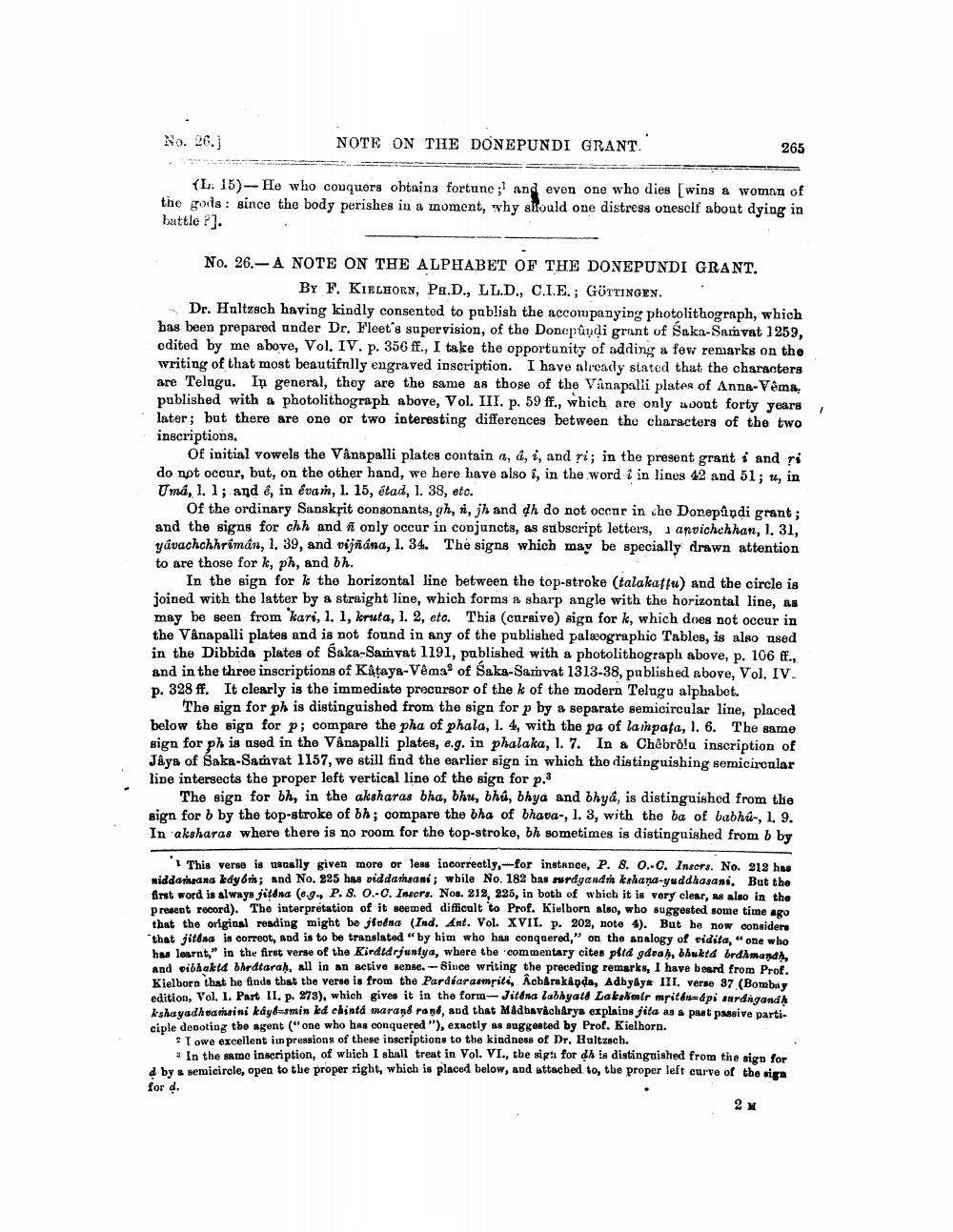________________
No. 26.)
NOTE ON THE DONEPUNDI GRANT
265
(L. 15) - He who conquers obtains fortune;' and even one who dies [wins & woman of the gors: since the body perishes in a moment, why should one distress oneself about dying in battle ?].
No. 26.- A NOTE ON THE ALPHABET OF THE DONEPUNDI GRANT.
BY F. Kielhorn, Pa.D., LL.D., C.L.E.; GÖTTINGEN. Dr. Haltzsch having kindly consented to pablish the accompanying photolithograph, which has been prepared under Dr. Fleet's supervision, of the Donepundi grant of Saka-Samvat 1259, edited by me above, Vol. IV. p. 356 ff., I take the opportunity of adding a few remarks on the writing of that most beautifnlly engraved inscription. I have already stated that the characters are Telugu. In general, they are the same as those of the Vanapalli plates of Anna-Vêma. published with a photolithograph above, Vol. III. p. 59 ff., which are only wont forty years, later; but there are one or two interesting differences between the characters of the two inscriptions.
Of initial vowels the Vânapalli plates contain a, a, i, and ri; in the present grant i and ri do not occur, but, on the other hand, we here have also i, in the word i in lines 42 and 51; u, in Umá, 1. 1; and e, in evan, 1. 15, étad, 1. 38, etc.
Of the ordinary Sanskțit consonants, gh, i, jh and dh do not occur in che Donepîndi grant; and the signs for chh and i only occur in conjuncts, as subscript letters, 1 apvichchhan, 1, 31, yavachchhriman, I. 39, and dijñana, 1. 34. The signs which may be specially drawn attention to are those for k, ph, and bh.
In the sign for k the horizontal line between the top-stroke (talakatfu) and the circle is joined with the latter by a straight line, which forms a sharp angle with the horizontal line, as may be seen from kari, 1, 1, keruta, 1, 2, etc. This (cursive) sign for k, which does not occur in the Vanapalli plates and is not found in any of the published palæographic Tables, is also used in the Dibbida plates of Saka-Samvat 1191, published with a photolithograph above, p. 106 ff., and in the three inscriptions of Kataya-Vêma of Saka-Samvat 1313-38, published above, Vol. IV. p. 328 ff. It clearly is the immediate precursor of the k of the modern Telugu alphabet.
The sign for ph is distinguished from the sign for p by a separate semicircular line, placed below the sign for p; compare the pha of phala, l. 4, with the pa of lampata, 1. 6. The same sign for ph is used in the Vânapalli plates, e.g. in phalaka, 1. 7. In a Chêrôlu inscription of Jâya of Saka-Samvat 1157, we still find the earlier sign in which the distinguishing semicircular line intersects the proper left vertical line of the sign for p.:
The sign for bh, in the aksharas bha, bhu, bhú, bhya and bhya, is distinguished from the sign for b by the top-stroke of bh; compare the bha of bhava-, 1.3, with the ba of babhú-, 1. 9. In aksharas where there is no room for the top-stroke, bh sometimes is distinguished from b by
'1 This verse is usually given more or less incorrectly,--for instance, P. 8. O.-C. Insors. No. 212 hss middawana kdy 6t; and No. 925 has viddarhsani; while No. 182 has rurdyandra kshana-yuddhasan. But the first word is always fitana (6.9., P. 8. 0.-C. Insors. Nos. 212, 225, in both of which it is very clear, as also in the prevent record). The interpretation of it seemed difficult to Prof. Kielborn also, who suggested some time ago that the original reading might be judna (Ind. Ant. Vol. XVII. p. 202, note 4). But he now considers "that jitána is correct, and is to be translated by him who has conquered," on the analogy of vidita,"one who has learnt," in the first verse of the Kirdldrjunys, where the commentary cites plid gdval, bhukta brdimandi, and vibhaktd brdtara), all in an active sense. -Since writing the preceding remarks, I have beard from Prof. Kielborn that he finds that the verse is from the Pardiaraamiti, Acharskapda, Adhyâya III. verse 97 (Bombuy edition, Vol. I. Part II. p. 273), which gives it in the form-Jitena labhyatt Lakatmir mit& dpisardiganah Lehavadheadwini kaydemin kd cbinta marand rand, and that Madbav obArys explains ita as pat passive parti. ciple denoting the agent ("one who has conquered"), exactly as suggested by Prof. Kielhorn.
I owe excellent in pressions of these inscriptions to the kindness of Dr. Rultzach.
* In the same inscription, of which I shall treat in Vol. VI., the sig for d is distinguished from the sign for d by a semicircle, open to the proper right, which is placed below, and attached to, the proper left curve of the sien for d.
2x




